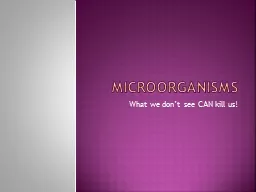

MicroorganismS What we dont see CAN kill us Microorganisms Also called microbes Cannot be seen without a microscope May be nonpathogen or pathogen depending on where it is in body Microorganisms ID: 763426
Download Presentation The PPT/PDF document "MicroorganismS What we don’t see CAN k..." is the property of its rightful owner. Permission is granted to download and print the materials on this web site for personal, non-commercial use only, and to display it on your personal computer provided you do not modify the materials and that you retain all copyright notices contained in the materials. By downloading content from our website, you accept the terms of this agreement.
MicroorganismS What we don’t see CAN kill us!
Microorganisms Also called microbes Cannot be seen without a microscope May be non-pathogen or pathogen depending on where it is in body
Microorganisms Aerobes are a variety of bacteria that require oxygen to grow. Anaerobes are bacteria that grow in the absence of oxygen and are destroyed by oxygen. Facultative anaerobes are organisms that can grow in either the presence or the absence of oxygen.
Types of Infections Endogenous - originates inside the body Exogenous-originates outside the bodyNosocomial- infection obtained in a health care facility (Ex: MRSA) Opportunistic - occurs when host resistance is down
Bacteria Single cell 3 types: Cocci, Bacilli, Spirilla
Bacteria-cocci Round shaped Micrococci - single cell Diplococci -two celled
Bacteria-Cocci Staphylococci -clustered Streptococci - in chains
Examples Of Cocci Diseases “Strep throat” Scarlet FeverRheumatic fever“Flesh eating” diseaseEndocarditis Pneumonia MRSA Toxic Shock
Bacteria-Bacilli Rod Shaped May have flagella that help the bacteria to moveOften produce sporesOccur singly, in pairs or in chains Many produce poisons called toxins
Spores Some bacteria change into the most resistant form of life known called spores. Bacteria remain alive in the spore form but are inactive. They can survive extremes of heat and dryness and even the presence of disinfectants and radiation.
Example of Bacillus Anthrax
Examples of diseases from Bacilli Leprosy Tuberculosis TetanusBotulismDiphteriaTyphoid
Bacteria-Spirilla Spiral shaped May be other “unusual” shapes Example: syphilis and cholera
BACTERIA-Rickettsiae The rickettsiae are short, nonmovable rods that normally live in the intestinal tract of insects such as lice, fleas, ticks, and mosquitoes. They are very small and require host cells to reproduce. Diseases caused by rickettsiae include typhus and Rocky Mountain spotted fever. These diseases are transmitted to humans by way of the bite of an infected insect.
chlamydia Smallest of all bacteria Originally thought to be a virus
Gram Staining Gram staining requires crystal violet dye, iodine solution, alcohol solution, and a safranin dye be used in a certain order.The bacteria that are stained by the dye are classified as Gram-positive. (They appear dark purple under the microscope.)Gram negative bacteria will appear pink. Bacteria that are positive but stain as negative are called Gram variable or there’s mixed colored staining.
Gram Positive
Gram negative
Bacteria Review
Algae Algae range from microscopic single-cell organisms to larger multiple-cell organisms such as seaweed and kelp. All algae contain chlorophyll, as well as pigments that cause them to appear yellow-green, brown, or red. Algae are found in abundance in both freshwater and marine habitats.Most algae do not produce human disease.
Algae Red Tide
Protozoa One celled animal-like, may contain flagella Often found in decayed materials, animal feces, and contaminated water Cause malaria, dysentery (severe diarrhea), and African sleeping sicknessNot too common in the US
Fungi Fungi are plants, such as mushrooms, yeasts, and molds, that lack chlorophyll. Diseases include athlete’s foot, vaginitis, “Jock itch”, and ringworm
Helminths Multi-cellular worms or flukes Can be injected in food or obtained when bitten by a mosquito Examples: pinworms, hookworms, trichinella spiralis, tapeworms
Virus Viruses are smallest of all microbes and only seen with electron microscope. Viruses can live and multiply only inside an appropriate host cell. A virus invades a host cell, copies itself, and then destroys the host cell so the viruses are released into the body.Spread from human to human through body secretions
Virus- Diseases HIV Common cold Influenza- Ex:H1N1HPV- Human Papilloma VirusPolioChickenpox Herpes Zoster- shingles Simplex Type 1- cold sores Simplex Type 2- genital herpes
Virus- Diseases Hepatitis HAV HBVHCVHDVHEV HGV Vowels: Food and Fecal Borne Consonants: Blood Borne
Prions Infectious agent composed of primarily protein that is misfolded Must reproduce inside a host cellGets the other proteins to misfold as well
Prions Prions are responsible for “mad cow” disease and possibly Alzheimer disease. Prion-caused diseases have been found in human beings and animals. Prions are highly resistant to heat, chemical agents, and irradiation. There is no treatment or vaccine against prion diseases, and the only preventive measure is not eating suspect food.
Microbes Tree Map Microorganisms Chlamydia Algae Protozoas Bacteria Viruses Cocci Micrococci Diplococci Staphylococci Streptococci Fungi Prions Helminths Bacilli Rickettsiae Spirilla